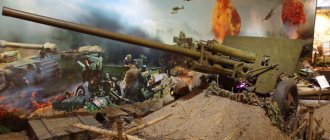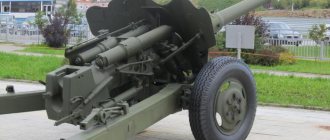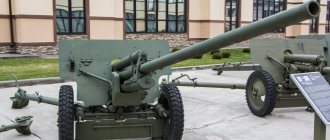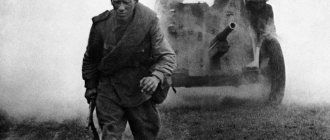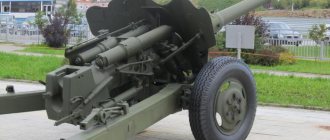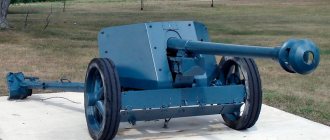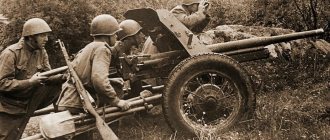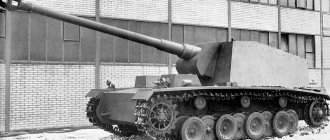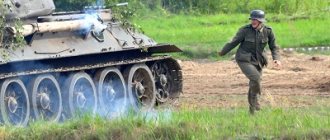Type of anti-tank gun
| 7.5 cm Pak 41 | |
| Preserved 7.5 cm PaK 41 | |
| Type | Anti-tank gun |
| Place of origin | Nazi Germany |
| Service history | |
| Used | Nazi Germany |
| Wars | The Second World War |
| Production history | |
| Designer | Krupp, Essen |
| Produced | 1941-1943 |
| No built | 150 |
| Characteristics | |
| Weight | 1,390 kg (3,064 lb) |
| Length | 4.325 m (14 ft 2.3 in) |
| Barrel length | 2.95 m (9 ft 8 in) |
| Crew | 5 |
| Shell | Fixed QF 75 × 543 mm R |
| Projectile weight | 2.5 kg (5 lb 8 oz) |
| Caliber | 75 mm (2.95 in) decreasing to 55 mm (2.16 in); 57 caliber length |
| Shipping | Split trail |
| Height | –12.5° to +16° |
| Traverse | 60 ° |
| starting speed | AP 1,230 m/s (4,035 ft/s) |
| Effective firing range | 2000 m (2185 yd) |
| Feeding system | single shot, breech loaded |
| Attractions | visible up to 1500 m |
7.5 cm Pak 41
was one of the last German anti-tank guns to enter service and use in World War II and is notable for being one of the largest anti-tank guns to rely on the Gerlich principle (pioneer German pistol designer Hermann Gerlich, who developed this principle in the 1920s , reportedly for a hunting rifle) provide higher muzzle velocity and therefore greater armor penetration relative to its size. [1]
It is similar to but different from the Waffe 0725, which, although based on the Gerlich principle, had a different barrel caliber. [2]
Design and development [edit]
Designed and manufactured by Krupp AG to compete with the Rheinmetall 7.5 cm Pak 40, the Pak 41 was originally intended to use the Goerlich principle to increase shot velocity. In addition to the bore design and the use of a tungsten core flanged body, the Pak 41 has several new features. One feature was that the barrel was divided into three distinct sections: the rear was parallel and traditionally rifled; the central part was uneven and tapered downwards; at the muzzle end the last 27.6 inches (700 mm) were again parallel, but remained without a notch. Another innovative feature was the attachment of split trail legs and solid rubber tires directly to the gun guard to save weight. The gun cradle was installed inside a special ball joint attached to the gun shield. The cradle itself was cylindrical and covered the entire rear half of the trunk.
The weight of the propellant charge fired was 95 percent of the weight of the projectile, which had a design velocity of approximately 1,200 m/s (4,000 ft/s) and homogeneous armor penetration of 15 cm (5.94 in) at a range of 900 m/s. m (1000 yards). Reinforced breech of vertical wedge type, semi-automatic action. Compared to the PaK 38 and PaK 40, they looked long, low and strong.
The sight is visible up to 1500 meters; The sight has four scales for use depending on the actual muzzle velocity of the machine gun. The barrel life is tentatively estimated at 500 to 600 shots.
Tungsten Eater
At the end of the summer of 1942, a German artillery piece fell into the hands of the Red Army, which aroused the interest of the Main Artillery Directorate of the Red Army. It was a new German anti-tank gun with a conical barrel 7.5 cm Pak 41. Several shells were captured along with the gun, which made it possible to conduct tests and determine its characteristics. What kind of weapon was this and what were the results of its tests in the USSR?
History of the Pak 41
After the first meetings of German troops in June 1941 with the new Soviet T-34 and KV tanks, it became obvious that the power of the standard 3.7 cm Pak anti-tank gun of infantry units was not enough to effectively combat them. It was possible to solve the problems of anti-tank defense with anti-aircraft and infantry artillery using direct fire, but these guns were poorly suited for these purposes: they had a high silhouette, low mobility and weak crew protection. Therefore, Germany accelerated work on creating more powerful anti-tank guns.
Pak 41 gun being tested at the Gorokhovets training ground of the GAU KA, autumn 1942 (TsAMO)
One of the areas of work to increase the power of anti-tank artillery was the creation of guns with conical barrels, using the principle of engineer Hermann Gerlich. Such systems included, for example, the heavy anti-tank rifle 2.8 cm schwere Panzerbüchse 41 (2.8 cm s.Pz.B. 41). The use of this principle made it possible to quickly create an effective anti-tank weapon with a high initial projectile velocity, which provided good armor penetration, but at the same time gave rise to a number of problems. The main ones were the low survivability of the barrel due to rapid wear and the use of scarce tungsten, from which the cores of armor-piercing projectiles were made.
By mid-1941, Germany experienced an acute shortage of tungsten, the deposits of which were located far beyond the borders of the Third Reich. It had to be delivered by sea by special blockade-breaking ships in small quantities. Mass production of a gun designed to use this material in its projectiles was not the best idea, but it was an option that the industry could come up with quickly.
By January 1942, two systems with a conical barrel of variable caliber 75/55 mm (at the breech 75 mm, at the muzzle 55 mm) had been developed: a joint development of Rheinmetall and Krupp under the designation Schwere 7, 5 cm Pak 44, as well as the 7.5 cm Pak 41 designed by Krupp.
7.5 cm Pak 41 (NARA) anti-tank gun barrel drawing
Tests have shown that the barrel life of the Schwere 7.5 cm Pak 44 is only about 250 shots. The 7.5 cm Pak 41 barrel was not more durable, but the design provided for the possibility of replacing a section of the barrel that was subject to a lot of wear directly in the field. As a result, the advantage was given to the 7.5 cm Pak 41.
Due to the lack of a full-fledged ability to provide the guns with ammunition, only 150 guns were ordered for Krupp, the production of which began in March 1942. At the same time, it was separately noted that the production of ammunition for this weapon will reduce the production of projectiles with a tungsten core for other anti-tank systems.
The cost of the gun was not much higher than that of the “traditional” Pak 40, which appeared a little later (about 15,000 Reichsmarks versus 12,000); 2,800 man-hours were spent on the production of one gun.
The release was distributed by month as follows: March - 48, April - 25, May - 77. Military acceptance was carried out with some delay: four guns were accepted in April, and the remaining 146 in May.
Combat use of the weapon
Of the 150 guns fired, 141 were immediately sent to the troops on the Soviet-German front and distributed among the anti-tank divisions of infantry and motorized divisions. Soon, rave reviews began to pour in from the front about the gun’s combat use.
A gun of the 36th anti-tank division of the 36th Wehrmacht infantry division in a firing position. Baranovichi region, spring 1944 (RGAKFD)
In August 1942, the Wehrmacht lost its first three guns, while one of them was captured by the Red Army in good condition, along with a small number of armor-piercing shells. A total of 17 Pak 41 guns were lost by the end of 1942.
A “shell famine” soon forced the Germans to look for a replacement for tungsten, but a new type of shell for the Pak 41 with a steel core turned out to be significantly worse in armor penetration. At the same time, another anti-tank gun, the 7.5 cm Pak 40, which was more traditional in terms of barrel and shells, proved itself to be excellent and subsequently began to be supplied en masse to the troops.
By April 1943, the Wehrmacht had 78 Pak 41 guns, and some of the losses were non-combat: some guns were dismantled for spare parts. On July 25, 1943, an entry appeared in the OKW (Oberkommando der Wehrmacht - Wehrmacht High Command) combat log:
“Due to a shortage of spare parts and difficulties with ammunition, Army Group Center transferred 65 7.5 cm Pak 41 guns to the high command in the West (Oberkommando
West - author's note), where they were repaired, put in order and further used by troops stationed on the coast for coastal defense
.
Low profile is a valuable quality for any anti-tank gun, and the Pak 41 met this requirement
However, even on the Atlantic Wall, these guns were soon no longer needed due to the lack of armor-piercing shells, but they were not written off or sent for melting down. Conical guns continued to remain in service and took part in battles against the Allies in 1944.
The number of Pak 41s in the army was steadily declining: on February 1, 1944 there were 56 of them, on April 1 - 44, on September 1 - 35, and by March 1, 1945, only 11 guns survived.
Tests in the Soviet Union
As already mentioned, in August 1942, one of the conical guns became a trophy of the Red Army, and on October 6, the Artillery Committee of the GAU KA issued an order to test it. The purpose of the tests was to compile a description of the gun, determine the armor penetration and ballistic characteristics of the system. Particular attention was required to be paid to recoil devices, semi-automatics and the bolt.
Pak 41 anti-tank gun during testing at the Gorokhovets training ground, right view (TsAMO)
The gun arrived at the Gorokhovetsky training ground of the GAU KA on October 22, 1942, along with six shells. The range documents indicate Pzgr.40, but this is an obvious mistake - if you tried to fire a projectile from a “regular” Pak 40, the barrel of a “conical” Pak 41 would simply be torn off. Therefore, it is now hardly possible to say what type of shells were actually used.
Tests on the stability of the gun when firing (jumping, throwing, recoil of the gun) were carried out during firing to determine the ballistic characteristics; three shells were used for this. The gun was aimed through the barrel - the sight of the captured gun was lost.
There are only three shells left for testing to determine armor penetration. It was planned to fire at a homogeneous armor plate 120 mm thick from a distance of 200 meters. In this case, the first shot was supposed to be fired at an angle of impact between the projectile and the armor of 60°. If there had been no penetration, the second shell would have been fired at an angle of 90°. If the armor was penetrated during the first shot, then for the second shot it was planned to use a slab with a thickness of 140–150 mm at an impact angle of 60°.
Sectional view of 7.5 cm Pak 41 shells
However, the tests went differently. There was no 120-mm armor at the test site, so for testing they took two slabs with dimensions of 1.2 × 1.2 meters, thickness 45 mm and 100 mm, with different cementation modes and hardness coefficients, and installed at 60° to the direction of the projectile flight . In addition, the 100 mm slab had already been shot at and was deformed, so it was not possible to install the slabs closely, and there was a gap of about 30 mm between them. The first one was a slab with a thickness of 45 mm. They shot from 200 meters, aiming again through the barrel.
The first shot failed to hit the target, so the second was fired from a distance of 100 meters. Alas, it was also unsuccessful - the shell hit the wooden frame that held the armor plates. The third shot, the last shell, was fired from a distance of 75 meters, and finally hit the target. The ballistic tip was crumpled, the core, having pierced the 45-mm plate, shattered into small fragments, the mangled shell of the projectile got stuck between the plates and in the pothole of the 100-mm plate.
A projectile after hitting armor plates at the GAU training ground (TsAMO)
Even one hit was enough to conclude that a projectile from the Pak 41 could penetrate 120 mm armor at a shell-to-armor angle of 60°. According to calculations, it was supposed to penetrate armor 195 mm thick at a distance of 500 meters and 170 mm at a distance of 1000 meters. Due to a shortage of shells, the Gorokhovets GAU training ground was unable to confirm the theoretical calculations of the Artillery Committee.
At this point the tests were completed. Based on the initial velocity of the projectile, determined to be 1190 m/s, it can be assumed that they fired a projectile not with a tungsten core, but a Pzgr. 41 St. - with steel.
Description of the 7.5 cm Pak 41 anti-tank gun
An anti-tank gun with a conical barrel of 75/55 mm caliber was designed to fight tanks and armored vehicles and could fire to suppress firing points and destroy manpower.
The gun was transported by mechanical traction, for which it was equipped with a torsion suspension mechanism, automatically turned off when the frames are moved apart, and a pneumatic brake controlled by the driver of the tractor. The wheels are metal, with solid rubber tires. A carriage with sliding frames made it possible to conduct horizontal fire in a sector equal to 60°.
View of the gun from the crew side (TsAMO)
The main parts of the gun were a barrel with a bolt, a cradle with recoil devices and a ball segment, lifting and turning mechanisms, a shield cover with running parts, and sighting devices.
A design feature of the Pak-41 was the absence of upper and lower gun mounts, while their presence was virtually standard for all types of guns, both then and now. The functions of the lower machine, and at the same time the main element to which everything was attached, were performed by the shield. It consisted of a package of two armor plates, each 7 mm thick, reinforced with intermediate bulkheads to increase rigidity.
A cradle with a ball segment, a move with a suspension mechanism for the machine, as well as guidance mechanisms were attached to the shield. At the same time, the shield provided reliable protection for the crew from shelling from all types of small arms at all distances; shrapnel was also largely harmless. The barrel passed through a spherical segment in the center of the shield - this method is more typical for casemate installations of bunkers than for anti-tank guns.
The shutter is vertical, wedge, semi-automatic. The sight is optical, periscope, for direct fire only. Sighting devices are located in the upper part of the cradle. The sight design made it possible to take into account barrel wear.
7.5 cm Pak 41 gun in transport position (TsAMO)
The monoblock barrel was composite and consisted of a pipe, a nozzle, a barrel bushing, a muzzle brake and a breech. The breech was connected to the pipe using a coupling. The nozzle was screwed onto the pipe, for which turnkey edges were cut on it closer to the muzzle. The joint between the pipe and the nozzle was covered with a sleeve, which was secured with a screw. The pipe channel had 28 grooves of constant steepness, the caliber of the pipe channel was 75 mm along the entire length, the length of the channel was 2965 mm.
The nozzle had a more complex design: its channel combined cylindrical and conical parts, and there were no rifling in it. Thus, the main wear occurred on this part of the barrel, and the design implied its rapid replacement by crews in the field. The length of the nozzle channel is 950 mm, the caliber at the beginning of the nozzle channel is 75 mm, at the muzzle – 55 mm. The length of the conical part is 450 mm, the length of the cylindrical part is 500 mm. The muzzle brake was slotted and screwed onto the barrel attachment. The design of the gun provided elevation angles from −10 to +18°.
Some historians and researchers incorrectly read the drawings and the accompanying text, which led to the erroneous opinion that the barrel attachment was collapsible and consisted of two parts.
Ammunition for Pak 41 and a tube container for its transportation
Four types of ammunition were created for the 7.5 cm Pak 41:
- Pzgr. 41 HK - a cartridge with an armor-piercing tracer projectile, with a tungsten core. Projectile weight 2.58 kg, initial speed 1260 m/s;
- Pzgr. 41 St. – a cartridge with an armor-piercing tracer projectile, with a steel core. Projectile weight 3.00 kg, initial speed 1170 m/s;
- Pzgr. 41 W. – cartridge with an armor-piercing tracer sub-caliber projectile. Projectile weight 2.48 kg, initial speed 1230 m/s;
- Spgr. 41 – cartridge with a fragmentation tracer grenade. Projectile weight 2.61 kg, initial speed 900 m/s.
According to Soviet calculations (according to Jacob de Marre's formula, strength coefficient K = 2400), an armor-piercing tracer projectile with an initial speed of 1200 m/s penetrated armor at an angle of encounter between the projectile and the armor of 60° at the following distances:
| Distance, m | 100 | 300 | 500 | 1500 | 2000 |
| armor thickness, mm | 132 | 125 | 120 | 91 | 79 |
According to the same estimates, a fragmentation tracer projectile could be accurately fired at a range of 4200 meters. According to German data, the armor penetration of the Pak 41 was:
| Projectile type | 100 m | 500 m | 1000 m | 1500 m |
| 7.5 cm Pzgr. Patr. 41 HK | 198 mm | 172 mm | 140 mm | — |
| 7.5 cm Pzgr. Patr. 41 W. | 97 mm | 80 mm | 70 mm | 60 mm |
The 7.5 cm Panzerjägerkanone (Pak) 41 gun was a unique weapon with outstanding characteristics, posing a threat to all types of both contemporary tanks and those that appeared in the first post-war years. Only a small series and a shortage of tungsten did not allow it to show its full potential. At the same time, acquaintance with the gun led to the beginning of work in the USSR to create several similar guns, especially since the appearance of new types of German tanks at the front was already known, and the armor penetration results of the Pak 41 were impressive.
Translation of German documents by Antonova V.A.
Sources
and literature :
- Documents from the fund of the Main Artillery Directorate (TsAMO RF)
- Waffen Revue No. 33, 1979
- Handbook on German military forces. War Department technical manual TM-E 30–451. War Department 03/15/1945 – US Government Printing Office. Washington, 1945
- Handbook of German artillery - M.: Military Publishing House NKO, 1945
- Artillery ammunition of the former German army. Directory. GAU USSR Armed Forces - M.: Military Publishing House of the Ministry of the Armed Forces of the USSR, 1946
- Documentation W 127: Datenblätter für Heeres Waffen Fahrzeuge Gerat. Karl. R. Pawlas, publizistisches Archiv für Militär- und Waffenwesen
Service [edit]
When first introduced, the performance of the 7.5 cm Pak 41 would seem to indicate that it could supplant the Pak 40 as the standard anti-tank gun for the Wehrmacht. However, the speed of the projectile tended to drop sharply over long distances, causing accuracy and penetration to suffer. This factor, along with a growing shortage of tungsten, which was needed for the gun's special ammunition, was to ensure that only 150 Pak 41s would ever be produced. Most Pak 41s were scrapped when their barrels wore out and/or their ammunition was depleted. although it is believed that a small number of Pak 41s were converted to accept 7.5 cm Pak 40 barrels and components.
Some of them were mounted on half-tracks and were used as lightly armored tank destroyers. [ citation needed
]
German anti-tank gun PaK 41 75mm (7.5 cm PaK 41) (1941-1943)
One of the latest developments of anti-tank guns for the Wehrmacht during the Second World War. About 150 guns were fired. One of the largest guns using the “Gerlich” principle, developed in the 1920s by a German engineer for a hunting rifle, to give higher velocity to the ammunition and, accordingly, increased stopping power.
PaK 41 75mm developed by . The gun competed (developed in parallel) with the 7.5 cm PaK 40. The anti-tank gun was originally created as a weapon with an increased firing speed and more effective penetration of the projectile behind the armor (armor-piercing power). When developing projectiles, tungsten cores were used, which increased the penetration of the projectile.
The PaK 41 75mm barrel is fixed in a spherical support, which is connected to a two-layer anti-fragmentation shield. The carriage frame and the gun axis were attached to the shield. Structurally, the shield was, as it were, part of the carriage. The barrel is of variable caliber, with a narrowing from 75mm at the breech to 55mm at the end of the barrel. Operational survivability 500-600 shots. The barrel consisted of three parts: - the first part was located closest to the breech, length 2.95 meters of cylindrical design; - the second part - put on the first part, length 95 centimeters, two-stage design. The internal channel had the shape of a cone; - the third part - like the first, was of a cylindrical type, length 700 mm.
The projectiles were provided with a crimpable soft sleeve. 95 percent of the ammunition was a powder charge. The conical part of the barrel wore out very quickly, but due to the fact that the barrel consisted of three parts, it could be quickly and easily changed/replaced in the field. The bolt is semi-automatic with a vertical wedge.
Due to its features, the gun had high rates of effective use - a projectile with a speed of 1200 m/s penetrated 15 centimeters of homogeneous armor at a distance of 900 meters. The effective range of use is 1.5 kilometers, maximum up to 2,000 meters.
Using 7.5 cm Pak 41
It would seem that the gun was superior in efficiency to the Pak 40 and should have driven it out of the German forces. However, it turned out that the velocity of the projectile drops sharply, as a result of which at ranges of more than 2 kilometers, ammunition fired from the PaK 41 75mm lost its main advantages (accuracy and penetration). In addition, tungsten was mined in rather small quantities and its reserves were quickly exhausted.
In 1943, Germany, experiencing a severe shortage of various rare elements, in particular tungsten, practically stopped producing ammunition with tungsten armor-piercing cores and the PaK 41 75mm was practically no longer used.
Serial production of the Pak 41 was cancelled; the small number of anti-tank guns in service were converted at the end of the war to accept 7.5 cm Pak 40 ammunition. Some more were installed on armored vehicles, which were used as destroyers of lightly armored tanks. The only surviving PaK 41 75mm gun is in the UK.
Main characteristics:
- type - anti-tank gun; — calculation – 5 people; — weight in combat/traveling position — 1356/1500 kilograms; - total barrel length - 4.32 meters; - ammunition weight - 2.5 kilograms; - caliber - 75X543mm with reduction to 55mm; - armor penetration: 500 meters - 17 cm, 900 meters - 15 cm; - average initial speed - 1150 m/s; - vertical/horizontal firing angles - (-12 to 16)/60 degrees; - effective/maximum firing range - 1500/2000 meters.
Sources of information: https://zweiter-weltkrieg-lexikon.de/index.php/Geschutze/Panzerabwehrkanonen-PAK/75-cm-Pak-41.html https://forum.guns.ru/forum/42/245591. html https://www.lonesentry.com/articles/ttt/75mm-tapered-bore-antitank-pak-41.html
Ammunition[edit]
Pzgr 41 (HK) [edit]
German 7.5 cm Pak 41 APCNR Shot
Armour-piercing, composite, non-rigid projectile with a sub-caliber tungsten core and tracer.
- Projectile weight
: 2.6 kg - Muzzle velocity
: 1230 m/s
| Classify | Penetration at an angle of 30 degrees from vertical [3] |
| 100 m | 198 mm |
| 500 m | 172 mm |
| 1000 m | 140 mm |
| 1500 m | n/a |
Pzgr 41 (W) - APCNR [edit]
An armor-piercing, non-rigid projectile marked only with practice.
- Projectile weight
: 2.5 kg - Muzzle velocity
: 1230 m/s
| Classify | Penetration at an angle of 30 degrees from vertical [3] |
| 100 m | 97 mm |
| 500 m | 80 mm |
| 1000 m | 70 mm |
| 1500 m | 60 mm |
Links and sources[edit]
Notes
- ↑
"The rifle is squeezed out at the rate of a second when firing"
Popular Mechanics
, August 1933. - 'daveh' (June 2, 2003). "Question about waffle 0725". Axis History Forum
. Retrieved October 25, 2015. Considering T Jentz's research standards... It appears that the 0725 Wafer is a different weapon than the Pak 41. - ^ ab Nachrichtenblatt zur Panzerbeschusstafel 7.5 cm Pak 41 L / 74.5 * from November 1942
Sources
- Gander, Terry and Chamberlain, Peter. Weapons of the Third Reich: An Encyclopedic Survey of All Small Arms, Artillery and Special Weapons of the German Ground Forces 1939-1945
. New York: Doubleday, 1979 ISBN 0-385-15090-3 - Hogg, Ian W. German Artillery of the Second World War
. 2nd revised edition. Mechanicsville, PA: Stackpole Books, 1997 ISBN 1-85367-480-X
| vteGerman artillery from World War II | |
| Tank guns |
|
| Anti-tank rifles |
|
| Infantry and mountain guns |
|
| Recoilless rifles |
|
| Mortars |
|
| Heavy mortars |
|
| Rocket artillery |
|
| Field, medium and heavy guns |
|
| Super-heavy and siege artillery |
|
| Railway artillery |
|
| Naval artillery |
|
| Anti-aircraft guns |
|
| Demolition fees |
|
